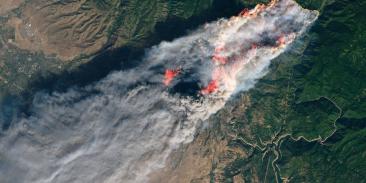How climate change makes hurricanes
more destructive
more destructive
As our climate warms, we’re experiencing stronger winds, higher storm surges and record rainfalls during hurricane season — which is also why these storms are becoming more destructive and costly.
Warmer oceans fuel storms
So why do hurricanes bring more rain in a warmer climate?
Evaporation intensifies as temperatures rise, and so does the transfer of heat from the oceans to the air. As the storms travel across warm oceans, they pull in more water vapor and heat, adding more energy to the storm.
That means heavier rainfall, stronger wind and more flooding when the storms hit land.
Sea level rise makes storm surges worse
Storm surge happens when waters rise above their normal levels and are pushed inland by wind.
This phenomenon is made worse by sea level rise, which is triggered by human-caused global warming as land ice melts and warmer ocean water expands.
The average global sea level has already risen by well over half a foot since 1880 — about four of those inches since 1993. Higher sea levels can push more water inland during hurricane-related storm surges.
In 2022, Hurricane Ian’s storm surge reached as high as 15 feet in Fort Myers Beach, Florida, flooding homes, making many unlivable and sweeping others away. With Hurricane Katrina, it was the storm surge that caused levees to fail, devastating the New Orleans area.
Take action: Ensure communities are prepared for extreme weather
Hurricanes are stronger, intensify faster
Stronger hurricanes are becoming more common in a warmer climate. Research suggests that the proportion of major hurricanes (Category 3 or above) in the Atlantic Ocean has doubled since 1980.
Hurricanes are also becoming stronger faster, a phenomenon known as rapid intensification. Scientists have found that climate change is leading to more favorable conditions for hurricanes to strengthen more quickly, such as warmer waters.
And when storms rapidly strengthen close to landfall, it means less time to prepare and evacuate, as we saw with Hurricane Michael in 2018 and Hurricane Otis in 2023. This can lead to catastrophic consequences, endangering lives and threatening more economic damage.
Meanwhile, hurricanes are traveling more slowly, making more damage possible. Slow-moving storms bring a higher risk of flooding as more rain is dumped over a particular area before a storm moves on.
Scientists are still debating exactly how this drop in speed is linked to climate change, but here’s the leading theory: The winds that steer hurricanes move more slowly in a warmer climate.
The damage we’ve seen from catastrophic hurricanes in recent years shows we need science more than ever to help us prepare for — and act on — climate change.
Take action: Ensure communities are prepared for extreme weather










